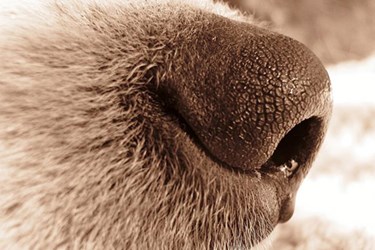Cancer-Sniffing Dogs Could Be The Key To New Diagnostics
By Joel Lindsey

According to a number of researchers, dogs and their ultrasensitive sense of smell could revolutionize efforts to create a reliable and accurate way to detect cancer — possibly leading the way for new medical devices.
“Our study demonstrates [that] the use of dogs might represent in the future a real clinical opportunity if used together with common diagnostic tools,” Gian Luigi Taverna, head of urology pathology at Istituto Clinico Humanitas in Rozzano, Italy, said at the 2014 Annual Meeting of the American Urological Association in Boston, according to Bloomberg Businessweek.
At the event, Taverna delivered a presentation on dogs’ abilities to detect the presence of cancer tumors. His research project represents the largest study ever done on cancer-sniffing dogs and indicated that dogs can detect prostate cancer in urine samples with 98 percent accuracy.
Research has found that when dogs detect cancer, they are actually picking up the scent of certain chemicals, known as volatile organic compounds (VOCs), which are emitted by tumors. The presence of VOCs has so far been discovered in tumors associated with lung cancer, colon cancer, prostate cancer, ovarian cancer, and breast cancer — a discovery that many feel could make possible new methods of cancer detection.
Dina Zaphiris, a dog trainer who researches dogs’ ability to detect early stage cancer, is currently working on producing a “canine medical scent detection kit.” According to Bloomberg Businessweek, the kit would allow patients to exhale through a tube and onto a VOC-capturing cloth. Specially trained dogs would then sniff the cloths to determine whether or not any VOCs are present. Zaphiris is working to submit the product to the FDA for review and approval.
While Zaphiris is working to commercialize the use of actual dogs, other researchers are focusing on creating electronic devices that would mimic a dog’s ability to detect VOCs.
Taverna’s research, for example, may lead to the development of “an electronic nose that follows nature’s lead in how a canine snout works,” according to Bloomberg Businessweek.
Similarly, researchers at the University of Pennsylvania’s Penn Vet Working Dog Center are working to develop a VOC-detecting device that could be used clinically.
“We’re trying a multiprong approach to determine if there’s some signature in blood in women with ovarian cancer so we can develop a detection system,” said Cindy Otto, director of the Penn Vet Working Dog Center, in the Bloomberg Businessweek article. “We’re using the dogs because we know the dogs are much more sensitive than any of our chemical techniques.”
Like Taverna, Otto says that she and her team of researchers are ultimately working toward developing an “electronic nose” that would accurately detect the presence of VOCs.
Image Credit: “Dog Nose.” Elucidate. 2008. CC By 3.0: http://creativecommons.org/licenses/by/3.0/deed.en
